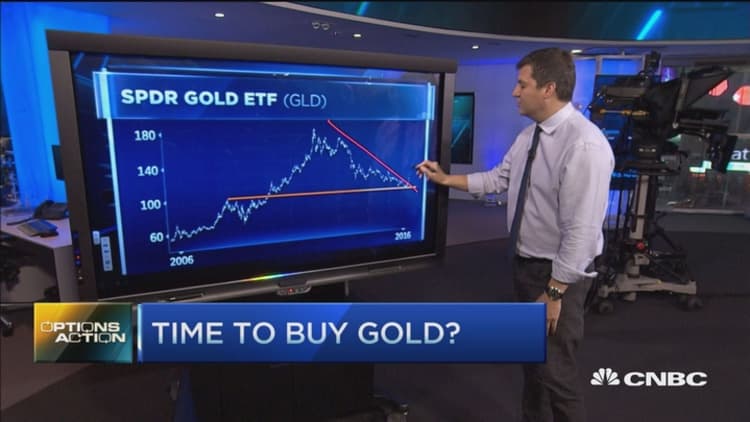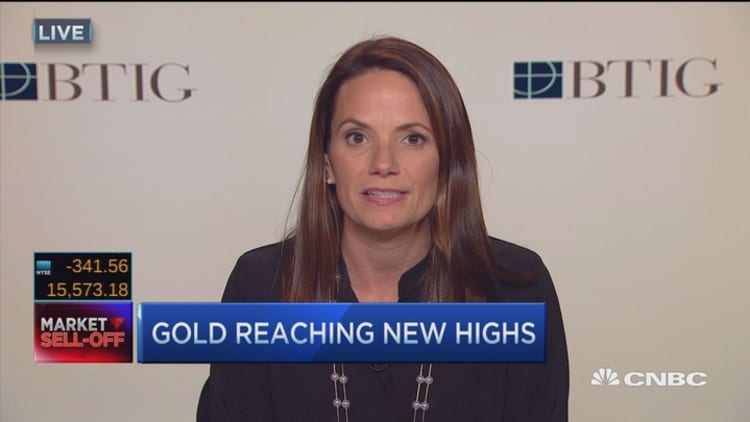

Investors should hold physical gold as a hedge in a market meltdown, some experts have advised, as equities continued their wild ride on Friday.
Jeffrey Nichols, a senior economic adviser to metals seller Rosland Capital, told CNBC's "Squawk Box" if retail investors planned to buy gold as a hedge against the financial risks present in today's stock markets, they should invest in gold they could hold in their hands.
Nichols said the best insurance for most investors was to have 5 to 10 percent of their investable assets in bullion coins such as American Eagles, Maple Leafs or Kruggerands, among others.
They are "the most liquid form of physical gold," he said. "Once you have got that, if you want to speculate or trade gold, you can trade derivatives, options, futures, and so forth," he said, adding that bullion coins had the extra advantage of being difficult to counterfeit.
Adrian Day, president at Adrian Day Asset Management, agreed. He told CNBC's "Street Signs" that investors should "start with bullion, it is the hedge, the security, the insurance," before going into gold mining stocks for leverage and speculation.
Gold is considered a safe-haven investment during times of market turmoil, and recent volatility has helped rise 17.1 percent this year to $1,242.70 an ounce on Friday. Gold mining stocks have also seen some big gains this year, with South Africa's Harmony Gold soaring 162.62 percent since the start of 2016.
At the same time, financial markets have come under tremendous pressure in a low growth, low interest rate environment. Concerns over China's economic slowdown, tepid global growth prospects and tanking oil prices are just some of the reasons why equity markets have sold off heavily since the beginning of the year.
The S&P 500 index, one of the most widely followed indexes, is down 5.7 percent for the year. Japan's is off 17.4 percent and China's is 22 percent lower for the same period.
One reason why gold is seeing an uptick in demand is because many investors, particularly institutions, are underweight gold, according to Day.
"One of the biggest things is gold is a hedge [against monetary turmoil]. Over the last several years, a lot of investors, particularly institutional investors, hedge funds, they didn't just need gold because they were making money elsewhere," the fund manager said.
Currency markets struggled to stabilize, meanwhile, while being pushed by forces including a pull-back on yen carry trades, uncertainty over the Fed's hiking path and bearish bets on the yuan.
The dollar index, where the dollar is weighted against a basket of currencies, is off 2.91 percent for the year. A strong dollar has traditionally been a headwind for gold, because gold is priced in dollar terms, so a weaker greenback makes gold even more attractive.
"When you see this kind of turmoil in monetary markets and you see all of the currencies fighting to go down, whether it's China or Brazil, they are all heading south [and] people want to hedge. Gold is the about the only hedge that makes sense," Day said.
Nichols added that current demand for gold was coming from speculative holders including hedge funds, commodity funds, institutional traders and bullion banks, where there was no attachment or sense of endurance.
"These companies have been [equities] sellers of late, and that's the reason why we've seen the stock market go down," he said. "It's the same set of players selling equities now and buying gold - a few months ago, they were still buying equities and selling gold."
Nichols forecasts that gold prices will double over the next three to seven years from their current levels.
"This is based on both the change in the economic environment, an improvement in speculative sentiment towards gold, and firming supply demand fundamentals," he said.
Mark Matthews, head of research for Asia at Bank Julius Baer, said in a note on Friday that gold's run upward would continue in the near term.
"At any moment there could be a rally in risk, which would send [gold prices] back down," he wrote.
"But few market participants think that rally when it comes will be sustainable, and after that markets will remain in a southerly direction for the next few months ... In which case, there is more room for gold (and its proxies) to move higher."
Nichols gave another reason to be optimistic on gold: A fundamental shift in gold ownership from the West to the East.
Many Asian countries, such as India, still had better growth prospects than Western countries and than global growth predictions.
Data from the World Gold Council released Thursday showed demand for the precious metal was resilient in 2015, despite a challenging start to the year, due to a strong demand in the second half from China and India.
Overall demand for gold was at 4,212 tones, similar to 2014's figure of 4,226 tones, with China and India accounting for 45 percent of total gold demand for the year. Consumer demand in the two countries was up 2 and 1 percent respectively. Global investment demand for the metal was up 8 percent on year.
"Most of this gold is going to be held for a long, long time. Maybe decades or longer," Nichols said.
CLARIFICATION
The report has been updated to reflect that Jeffrey Nichols is senior economic adviser to Rosland Capital.



